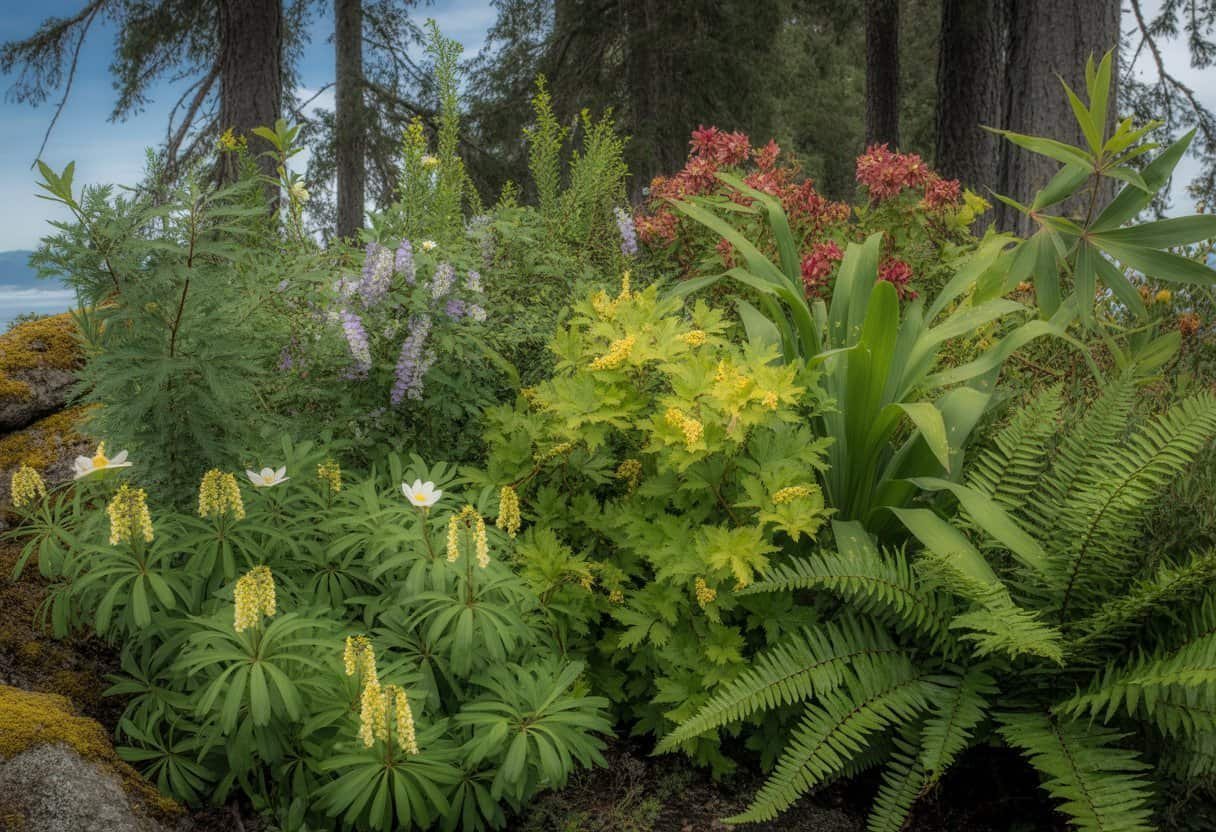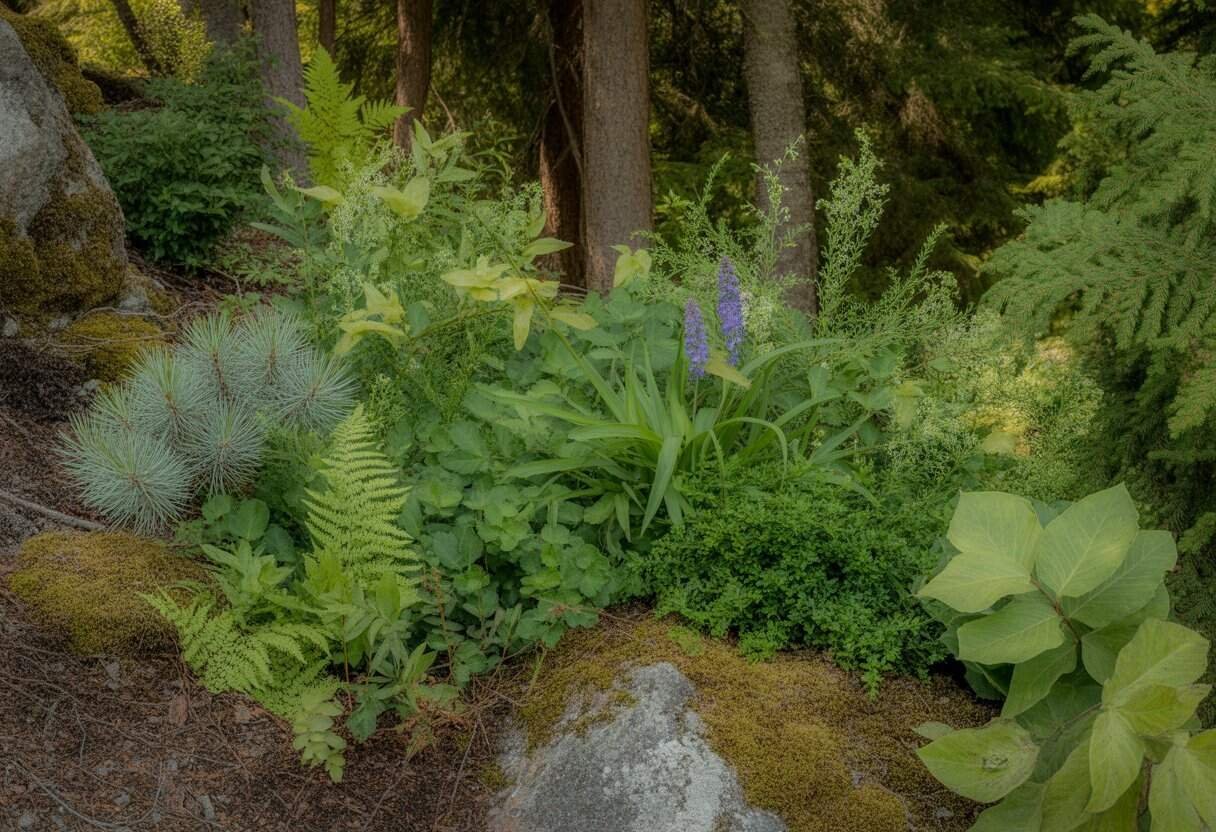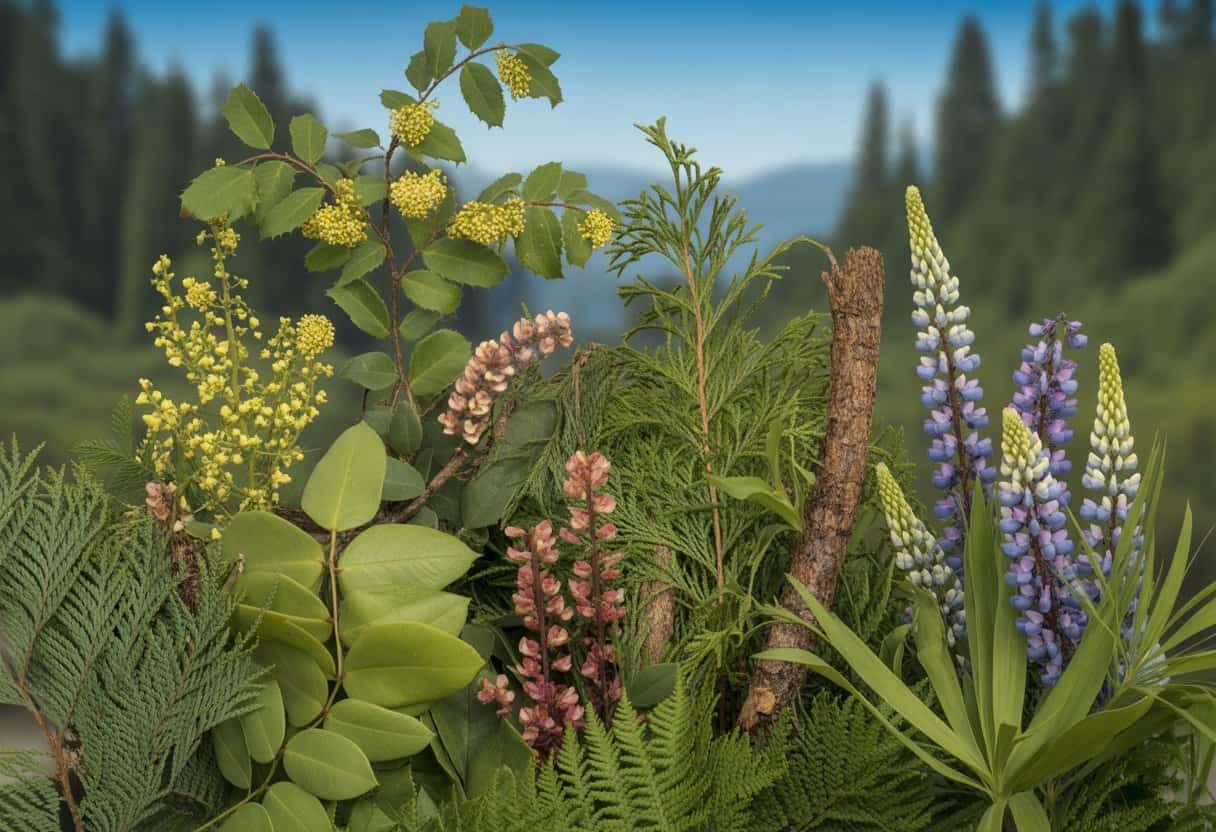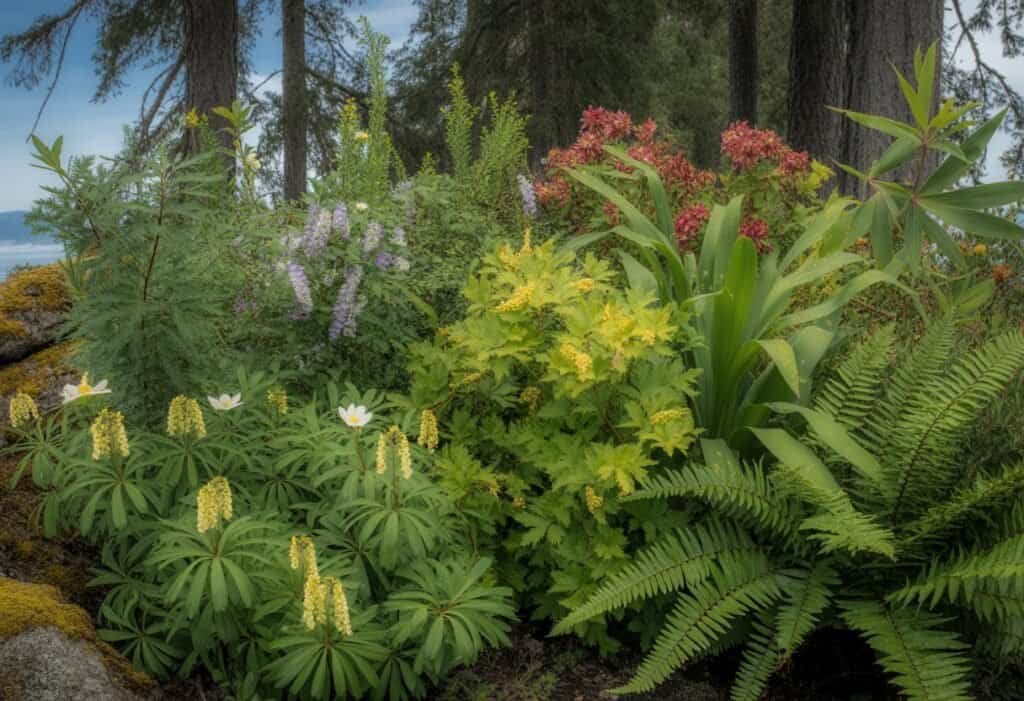Washington native plants offer a unique blend of beauty and resilience shaped by the diverse ecosystems across the state. From the coastal rainforests to the eastern deserts, these indigenous species have adapted to local conditions over thousands of years.
Native plants support local wildlife, require less maintenance once established, and help preserve Washington’s natural heritage for future generations.

These plants come in many forms—towering Douglas firs, delicate trilliums, and hardy sagebrush all call Washington home. They’ve evolved alongside local wildlife, creating relationships that non-native plants cannot replicate.
Many gardeners enjoy adding these native species to their landscapes.
Key Takeaways
- Washington native plants are adapted to local conditions, requiring less water and maintenance than non-native alternatives.
- The state’s diverse regions support different plant communities, from coastal species to alpine meadow flowers.
- Organizations like the Washington Native Plant Society offer resources and community support for identifying and growing native species.
Defining Washington Native Plants

Washington’s native plants have evolved and adapted to the region’s unique climate and soil conditions over thousands of years. These specialized plants form the backbone of local ecosystems and provide essential habitat for wildlife.
What Makes a Plant Native
Native plants are species that occurred naturally in Washington before European settlement. These plants evolved in the region over thousands of years without human introduction.
They developed alongside local wildlife, forming intricate relationships with pollinators, seed dispersers, and other organisms. A plant is considered native to Washington if it grew here prior to the 1850s, when significant European settlement began.
This timeframe serves as an important ecological baseline. Native plants are perfectly matched to local growing conditions.
They’ve adapted to Washington’s diverse climates, from the rainy western regions to the dry eastern areas. These adaptations help them thrive with minimal care once established.
The natural distribution of native plants depends on factors like:
- Soil type and pH
- Rainfall patterns
- Temperature ranges
- Elevation
- Sun exposure
Characteristics of Washington’s Flora
Washington’s native flora is incredibly diverse due to the state’s varied landscapes and climate zones. The Cascade Mountains create distinct growing regions with different plant communities.
Western Washington features:
- Coniferous forests dominated by Douglas fir, western red cedar, and western hemlock
- Lush understory plants adapted to shade and moisture
- Species that tolerate high rainfall and mild temperatures
Eastern Washington showcases:
- Drought-tolerant shrubs and grasses
- Plants adapted to extreme temperature swings
- Species that thrive in arid conditions
Many Washington natives display remarkable adaptations. Some forest understory plants have broad leaves to capture limited sunlight.
Others, like manzanita, have tough, waxy leaves to prevent water loss in dry conditions. Native plants typically follow seasonal patterns aligned with local wildlife needs, providing food and habitat at crucial times.
Native Plants vs. Non-Native and Invasive Species
Native plants differ significantly from non-native species, which people introduced from other regions. While some non-natives coexist peacefully, others become invasive and disrupt ecosystems.
Native plants:
- Support local wildlife with familiar food sources
- Require minimal maintenance once established
- Don’t need fertilizers or pesticides
- Conserve water through deep root systems
- Help prevent erosion
Non-native invasive plants:
- Outcompete natives for resources
- Disrupt natural food webs
- Reduce biodiversity
- Often lack natural predators or controls
- Can alter soil chemistry
Examples of problematic invasives in Washington include Himalayan blackberry, English ivy, and Scotch broom. These aggressive plants can form monocultures, crowding out diverse native plant communities.
Not all non-natives become invasive. Many garden plants remain well-behaved.
However, native plants offer unique ecological benefits that imported species cannot provide.
Regional Diversity and Significant Species

Washington state hosts an incredible variety of native plants thanks to its diverse landscapes, from coastal rainforests to eastern deserts. The state’s unique geography creates distinct plant communities with species that have adapted to specific local conditions.
Major Plant Habitats Across Washington
Washington’s plant communities are divided by the Cascade Mountains into two distinct regions. The western side receives abundant rainfall, supporting lush temperate rainforests dominated by massive conifers.
These forests feature Douglas fir (Pseudotsuga menziesii), western hemlock, and western red cedar. Eastern Washington presents a dramatic contrast with dry, open landscapes.
The Columbia Basin features sagebrush steppe communities, while the northeastern mountains support ponderosa pine forests. The Cascades themselves host unique subalpine and alpine communities.
At higher elevations, subalpine fir (Abies lasiocarpa) and mountain hemlock thrive in the harsh conditions. Alpine meadows showcase colorful wildflower displays during their brief summer growing season.
Riparian zones along rivers statewide create important habitat corridors. These areas feature distinctive species like black cottonwood and various willows including Hooker’s willow (Salix hookeriana).
Iconic Native Trees
Douglas fir (Pseudotsuga menziesii) stands as Washington’s most recognizable tree. It grows to massive heights and forms the backbone of western forests.
These trees can live over 1,000 years and reach heights exceeding 300 feet. Bigleaf maple (Acer macrophyllum) provides dramatic fall color with its massive yellow leaves.
Its broad canopy creates important habitat for mosses and ferns. Grand fir (Abies grandis) thrives in moist forests west of the Cascades.
It has a symmetrical form and distinctive needles with two white bands underneath. Pacific madrone (Arbutus menziesii), also called madrona, brings unique character to coastal and dry sites.
Its smooth reddish bark, evergreen leaves, and red berries stand out. These trees often grow with twisted, sculptural forms on exposed slopes.
Notable Shrubs and Herbaceous Plants
Cascara (Rhamnus purshiana) serves as one of Washington’s most valuable understory shrubs. This small tree produces black berries that feed wildlife and has bark traditionally used for medicinal purposes.
Douglas maple (Acer glabrum) brightens forest edges with vibrant fall colors. This adaptable shrub or small tree grows across various habitats statewide.
The Washington flora checklist documents thousands of native herbaceous plants. Trilliums, lupines, and penstemons provide remarkable diversity and create spectacular seasonal displays.
Native salal and huckleberry species produce edible berries important to both wildlife and humans. These common shrubs form dense understory thickets in western forests.
Alpine wildflower meadows feature iconic species like avalanche lily and paintbrush. These plants have adapted to the short growing season with rapid flowering cycles.
Resources for Plant Identification
Finding the right tools to identify Washington’s native plants makes exploration easier and more rewarding. Several reliable resources exist specifically for Pacific Northwest flora identification.
Native Plant Field Guides
Essential Washington Plant Guides:
- Plants of the Pacific Northwest Coast by Pojar and MacKinnon covers over 800 species with color photos and detailed descriptions.
- Wildflowers of the Pacific Northwest by Turner and Gustafson organizes plants by flower color for quick identification.
- Alpine Plants of the Northwest by Pojar focuses on mountain species in Washington’s higher elevations.
These guides include key identifying features, habitat information, and traditional uses of plants. Many include range maps showing where plants naturally grow in Washington.
Look for waterproof field guides if you plan to explore during Washington’s rainy seasons. Pocket-sized options work well for day hikes.
More comprehensive guides serve better for detailed study at home.
Herbarium Collections and Digital Databases
The Burke Museum Herbarium at the University of Washington houses over 650,000 plant specimens. Their collection includes plants dating back to the 1830s.
The Burke Herbarium Image Collection offers free online access to thousands of plant photographs and specimen images. This database allows searching by scientific name, family, or location.
Other helpful digital resources include:
- Washington Native Plant Society’s online plant directory
- USDA PLANTS Database with distribution maps
- iNaturalist app for crowd-sourced identification help
- Washington Rare Plant Field Guide (online)
These databases provide high-quality images, range information, and identification tips for Washington’s diverse native flora.
Tips for Identifying Washington Natives
When identifying native plants, focus on multiple characteristics rather than just flowers. Look at leaf arrangement (opposite or alternate), leaf shape, and growth habit.
Helpful identification techniques:
- Photograph plants from multiple angles
- Note the habitat where you found the plant
- Check for distinctive features like leaf edges, hairiness, or scent
Carry a small magnifying lens to examine tiny plant parts. Many species can only be differentiated by small details like the number of petals or leaf vein patterns.
Join a Washington Native Plant Society field trip to learn from experienced botanists. These guided walks help beginners learn identification skills firsthand in natural settings.
Consider seasonal changes in appearance. Many plants look different throughout the year, making identification challenging for beginners.
Plant Lists and Checklists
Finding reliable native plant lists helps Washington gardeners and conservationists make informed choices. These resources catalog the diverse flora found across the state’s varied landscapes and provide essential information for restoration projects.
Comprehensive Native Plant Lists
The Washington Flora Checklist serves as the definitive resource for plant identification in the state. Maintained by the Burke Museum, this list contains over 3,500 native species documented in Washington.
The checklist provides scientific names, common names, and distribution information for each plant. Several organizations offer searchable databases that allow users to filter native plants by characteristics:
- Washington Native Plant Society maintains an extensive plant list with photographs and growing requirements
- USDA PLANTS Database includes detailed distribution maps for Washington natives
- King County Native Plant Guide features commonly available species with cultivation notes
These comprehensive resources help both beginners and experts identify suitable native plants for their projects.
Specialized Lists by Habitat and Ecoregion
Washington’s diverse landscapes require specialized plant lists tailored to specific growing conditions. The state contains several distinct ecoregions, each supporting unique plant communities.
For coastal areas, the Coastal Native Plant Guide identifies salt-tolerant species adapted to maritime conditions. In eastern Washington, drought-tolerant plant lists help gardeners select species that thrive with minimal irrigation.
Other specialized resources include:
- Riparian plant lists for stream and wetland restoration
- Alpine and subalpine species guides for mountain regions
- Prairie plant lists for Puget Sound lowlands
The Washington Department of Fish and Wildlife offers habitat-specific plant recommendations for wildlife gardens. These specialized lists help ensure higher success rates when planting in challenging sites by matching plants to their preferred natural habitats.
Restoration and Landscape Uses
Washington native plants play crucial roles in ecosystem recovery and sustainable landscaping. These versatile plants help restore damaged habitats while creating beautiful, low-maintenance landscapes that support local wildlife.
Ecological Restoration Projects
Native plants form the foundation of successful habitat restoration in Washington. Organizations like the Washington Native Plant Society partner with government agencies to revegetate disturbed areas following construction, wildfire, or invasive species removal.
Douglas fir, western red cedar, and salal excel in forest restoration projects. In wetland recovery, sedges, rushes, and willows stabilize soil and filter pollutants.
Riparian restoration often includes red osier dogwood, vine maple, and Oregon ash to prevent erosion and cool stream temperatures for salmon. These plants establish quickly with minimal maintenance.
Several notable restoration successes include:
- Nisqually Delta restoration (500+ acres)
- Elwha River restoration following dam removal
- Urban stream daylighting projects in Seattle and Tacoma
Benefits in Sustainable Landscaping
Native plants need much less water, fertilizer, and pesticides than non-native plants. Once established, these plants thrive with little help, which lowers maintenance costs and reduces environmental impact.
Pacific rhododendrons, salal, and sword ferns provide year-round interest and support pollinators. Native grasses like Idaho fescue can replace traditional lawns, so you don’t need to mow or water as often.
These plants improve soil health through deep root systems. Their roots prevent erosion and help water soak into the ground, which reduces stormwater runoff and flooding risks.
Wildlife benefits are substantial. Native landscapes provide nectar for pollinators, seeds and fruits for birds, shelter for small mammals, and host plants for butterfly larvae.
Native Plant Landscape Design Principles
Start native plant landscaping with a site analysis. Match plants to your soil type, sun exposure, drainage, and microclimates.
Group plants with similar water needs together using hydrozoning. This method uses water efficiently and keeps plants healthy.
Key design strategies include:
- Creating plant communities instead of isolated specimens
- Layering vegetation such as trees, shrubs, and groundcovers
- Including plants with seasonal interest
- Adding habitat features like brush piles and rock gardens
You can design native landscapes in formal or naturalistic styles. Even small spaces benefit from container-grown natives like kinnikinnick, coastal strawberry, and nodding onion.
For a unified look, repeat key species and keep clean edges where native areas meet traditional landscaping.
Propagation and Cultivation of Native Plants
Growing Washington native plants in home gardens helps preserve local ecosystems. These plants create beautiful, low-maintenance landscapes.
Washington natives have adapted to local conditions over thousands of years. They are excellent choices for sustainable gardening.
Seed Collection and Propagation Methods
Collect seeds from Washington native plants when they are fully mature but before they disperse. For many species, this happens in late summer or early fall.
Different native plants need specific propagation techniques. Some seeds need cold stratification, which means storing them in damp sand in a refrigerator for one to three months.
Other seeds need scarification. Gently scratch the seed coat with sandpaper or nick it with a knife to help water soak in.
Use division for established perennials like Oregon grape or sword ferns. Dig up the plant in early spring or fall and separate the roots into smaller sections.
Take cuttings from woody natives like salal and snowberry. Cut 4-6 inch pieces in spring or early summer, remove lower leaves, and plant them in potting medium.
Caring for Native Plants in Gardens
Native plants usually need less care than non-natives once they are established. Most Washington natives require little watering after their first year, but water deeply during long dry spells.
Avoid heavy fertilizing. Most natives have adapted to Washington’s lean soils, and too much fertilizer can cause weak growth or fewer flowers.
Apply 2-3 inches of organic mulch to suppress weeds and keep soil moist. Use wood chips, fallen leaves, or bark for woodland natives.
Prune only dead or damaged branches. Avoid heavy shearing that creates unnatural shapes.
Group plants with similar water and light needs for easier care. Plan for the mature size of each plant to prevent overcrowding.
Ethnobotanical and Cultural Significance
Washington’s native plants have played a vital role for indigenous peoples for thousands of years. These plants provided food, medicine, materials for crafts, and spiritual significance.
Traditional Uses by Indigenous Peoples
The Coast Salish, Yakama, Colville, and other Washington tribes developed deep knowledge of native plants. Cedar trees were sacred, and people harvested bark for clothing, baskets, and housing materials by carefully stripping it in vertical sections.
Camas bulbs served as a crucial food source. People harvested them in spring and pit-roasted them to make them easier to digest. Tribes managed camas meadows with controlled burns.
Oregon grape root treated liver ailments and infections. Devil’s club helped with diabetes, respiratory issues, and rheumatism.
Salmonberry shoots provided vitamin C in early spring. Wapato tubers offered a starchy food similar to potatoes.
People needed to know the right seasons, habitats, and preparation methods to use these plants.
Cultural and Modern Applications
Native plant knowledge still shapes Washington culture. Basketry using cedar, sweetgrass, and beargrass remains an important tradition, with master weavers teaching younger generations.
Modern herbalists and naturopaths use traditional plant knowledge in treatments. Nootka rose and yarrow appear in teas and tinctures for their medicinal properties.
Native plant gardens at schools and public spaces now teach people about these plants. The Burke Museum in Seattle features ethnobotany exhibits that connect visitors to indigenous knowledge.
Several Washington tribes run native plant nurseries. These nurseries support cultural revitalization and ecological restoration. The Tulalip Tribes grow traditional food and medicine plants for tribal members.
Food sovereignty movements use native plants like huckleberries, camas, and wapato in modern diets. These efforts help reclaim health traditions disrupted by colonization.
Organizations and Further Learning
Several organizations in Washington State offer resources, workshops, and community events about native plants. These groups help you learn more and connect with other plant enthusiasts.
Washington Native Plant Society
The Washington Native Plant Society (WNPS) is the main resource for native plant information in the state. Founded in 1976, WNPS has 12 regional chapters across Washington.
WNPS organizes plant identification workshops, native plant sales, and restoration projects. Their monthly presentations feature expert speakers on topics like pollinator relationships and ethnobotany.
Members receive the quarterly journal Douglasia, which has in-depth articles about Washington’s native flora. The society also publishes field guides and maintains an online database of native plants.
Each year, the Native Plant Study Weekend brings together botanists and enthusiasts for field trips in different regions.
Continuing Education and Citizen Science
Other institutions offer native plant courses and citizen science opportunities. The University of Washington Botanic Gardens provides certificate programs and weekend workshops on native plant identification and landscape design.
Popular Citizen Science Projects:
- The Great Pollinator Project
- Rare Plant Monitoring Program
- Phenology tracking through Nature’s Notebook
Community colleges throughout Washington offer classes on native plant propagation and sustainable landscaping. Many conservation districts host annual native plant sales with expert advice.
Online resources like iNaturalist let plant enthusiasts share observations and improve their identification skills. These platforms connect observations to scientific research on climate change.
Frequently Asked Questions
Washington state has a rich diversity of native plants that thrive in many environments. These plants have adapted to local conditions over thousands of years, making them great for sustainable landscaping.
What are some common native plants found in Western Washington for landscaping?
Western Washington gardens benefit from many beautiful native plants. Douglas fir, Western red cedar, and Western hemlock are iconic trees that provide structure and habitat.
For shrubs, try salal, Oregon grape, and red-flowering currant. These offer glossy foliage, colorful berries, or spring flowers.
Ground covers like kinnikinnick, wild strawberry, and coastal strawberry fill spaces between larger plants. Native ferns such as sword fern and deer fern do well in shady spots.
Where can I purchase native plants for my garden in Washington?
Native plant nurseries operate throughout Washington state. These businesses focus on local species and often offer helpful advice.
Annual native plant sales by conservation districts, garden clubs, and native plant societies are good opportunities to buy local plants. These events usually happen in spring and fall.
Some garden centers now have native plant sections. Online retailers specializing in native plants deliver throughout Washington, making it easier to find rare species.
How can I identify native plant species in Washington?
Field guides for Pacific Northwest flora are great for plant identification. Choose guides with clear photos and detailed descriptions.
Apps like iNaturalist and PlantNet help you identify plants from photos. You take a picture, and the app suggests possible matches.
The Washington Native Plant Society offers workshops, field trips, and online resources to help people learn about native species. Their website includes plant lists by region and habitat.
Which native plants are recommended for Eastern Washington climates?
Eastern Washington’s dry climate supports different native plants. Ponderosa pine, Rocky Mountain juniper, and quaking aspen are well-suited trees.
Drought-tolerant shrubs like big sagebrush, antelope bitterbrush, and snowberry thrive in Eastern Washington. These plants need little extra water once established.
Wildflowers such as arrowleaf balsamroot, yarrow, and blanketflower add color and handle temperature extremes. Native bunch grasses like Idaho fescue and bluebunch wheatgrass work well in dry landscapes.
What are the best native flowers to grow in Washington state?
Red columbine attracts hummingbirds with its red and yellow blooms. This perennial grows in many conditions across Washington.
Camas produces blue-purple flowers in spring. It grows best in places that are moist in spring but dry in summer.
Pacific bleeding heart has delicate pink flowers for woodland gardens. Henderson’s shooting star, Douglas aster, and western trillium offer more options for different gardens.
How many species of native plants exist in Washington state?
Washington hosts approximately 3,100 native plant species. This diversity comes from the state’s varied topography, climate zones, and ecosystems.
The Cascade Mountain range creates distinct growing regions. These regions contribute to plant diversity.
Western Washington’s mild, rainy climate supports different species. Eastern Washington has drier, more extreme conditions that support other types of plants.
Alpine zones, coastal areas, shrub-steppe regions, and temperate rainforests each have unique plant communities. Washington stands out as one of the botanically richest states in the nation.


